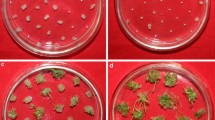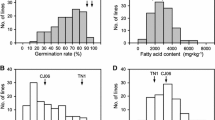Abstract
High embryogenesis capacity of soybean (Glycine max (L.) Merr.) in vitro possessed potential for effective genetic engineering and tissue culture. The objects of this study were to identify quantitative trait loci (QTL) underlying embryogenesis traits and to identify genotypes with higher somatic embryogenesis capacity. A mapping population, consisting of 126 F5:6 recombinant inbred lines, was advanced by single-seed-descent from cross between Peking (higher primary and secondary embryogenesis) and Keburi (lower primary and secondary embryogenesis). This population was evaluated for primary embryogenesis capacity from immature embryo cultures by measuring the frequency of somatic embryogenesis (FSE), the somatic embryo number per explant (EPE) and the efficiency of somatic embryogenesis (ESE). A total of 89 simple sequence repeat markers were used to construct a genetic linkage map. Six QTL were associated with somatic embryogenesis. Two QTL for FSE were found, QFSE-1 (Satt307) and QFSE-2 (Satt286), and both were located on linkage group C2 that explained 45.21 and 25.97% of the phenotypic variation, respectively. Four QTL for EPE (QEPE-1 on MLG H, QEPE-2 on MLG G and QEPE-3 on MLG G) were found, which explained 7.11, 7.56 and 6.12% of phenotypic variation, respectively. One QTL for ESE, QESE-1 (Satt427), was found on linkage group G that explained 6.99% of the phenotypic variation. QEPE-2 and QESE-1 were located in the similar region of MLG G. These QTL provide potential for marker assistant selection of genotypes with higher embryogenesis.





Similar content being viewed by others
References
Armstrong CL, Romero-Severson J, Hodges TK (1992) Improved tissue culture response of an elite maize inbred through backcross breeding and identification of chromosomal regions important for regeneration by RFLP analysis. Theor Appl Genet 84:755–762
Bailey MA, Boerma HR, Parrot DW (1993) Genotype effects on proliferative embryogenesis and plant regeneration of soybean. In Vitro Cell Dev Biol-Plant 29P:102–108
Barwale UB, Kerns HR, Widholm JM (1986) Plant regeneration from callus cultures of several soybean genotypes via embryogenesis and organogenesis. Planta 167:473–481
Beaumont VH, Rocheford TR, Widholm JM (1995) Mapping the anther culture response gene in maize (Zea mays L.). Genome 38:968–975
Ben Amer IM, Korzun V, Worland AJ, Brner A (1997) Genetic mapping of QTL controlling tissue-culture response on chromosome 2B of wheat (Triticum aestivum L.) in relation to major genes and RFLP markers. Theor Appl Genet 94:1047–1052
Bentolila S, Hardy T, Guitton C, Freyssinet G (1992) Comparative genetic analyses of F2 plants and anther culture derived plants of maize. Genome 35:575–582
Blum A, Klueva N, Nguven HT (2001) Wheat cellular thermo tolerance is related to yield under heat stress. Euphytica 117:117–123
Chen X-W, Cistué L, Muñoz-Amatriaín M, Sanz M, Romagosa I, Castillo AM, Vallés MP (2007) Genetic markers for doubled haploid response in barley. Euphytica 158:287–294
Cregan PB, Jarvik T, Bush AL, Shoemaker RC, Lark KG, Kahler AL, VanToai TT, Lohnes DG, Chung J, Specht JE (1999) An integrated genetic linkage map of the soybean genome. Crop Sci 39:1464–1490
Flores BE, Gentzbittel L, Mokrani L, Alibert G, Sarrafi A (2000) Genetic control of early events in protoplast division and regeneration pathways in sunflower. Theor Appl Genet 101:606–612
Gamborg OL, Miller RA, Ojima K (1968) Nutrient requirements of suspension cultures of soybean root cells. Exp Cell Res 50:151–158
Guo WW, Cheng YJ, Chen CL, Deng XX (2006) Molecular analysis revealed autotetraploid, diploid and tetraploid hybrid plants regenerated from an interspecific somatic fusion in Citrus. Sci Hortic 108(2):162–166
Hodges TK, Kamo KK, Imbrie CW, Becwar MR (1986) Genotype specificity of somatic embryogenesis and regeneration in maize. Bio/Technology 4:219–223
Komatsuda T, Ohyama K (1988) Genotypes of high competence for somatic embryogenesis and plant regeneration in soybean Glycine max. Theor Appl Genet 75(5):695–700
Komatsuda T, Kaneko K, Oka S (1991) Genotype × sucrose interactions for somatic embryogenesis in soybean. Crop Sci 31:333–337
Komatsuda T, Li WB, Oka S (1992) Maturation and germination of somatic embryos affected by sucrose and plant growth regulators in soybeans Glycine gracilis Skvortz and Glycine max (L.) Merr. Plant Cell Tiss Org Cult 28:103–113
Komatsuda T, Taguchi-Shiobara F, Oka S, Takaiwa F, Annaka T, Jacobsen HJ (1995) Transfer and mapping of the shoot differentiation locus Shd1 in barley chromosome 2. Genome 38:1009–1014
Koorneef M, Bade J, Hanhart C, Horsman K, Schel J, Soppe W, Verkerk R, Zabel P (1993) Characterization and mapping of a gene controlling shoot regeneration in tomato. Plant J 3:131–141
Kwon YS, Kim KM, Eun MY, Sohn JK (2002) QTL mapping and associated marker selection for the efficacy of green plant regeneration in anther culture of rice. Plant Breed 121(1):10–16
Lander ES, Green P, Abrahamson J, Baarlow A, Daly MJ, Lincoln SE, Newburg L (1987) MapMaker: an interactive computer package for constructing primary genetic linkage maps of experimental and natural populations. Genomics 1:174–181
Lazar MD, Bainziger PS, Schaeffer GW (1984) Combining abilities and heritability of callus formation and plantlet regeneration in wheat (Triticum aestivum L.) anther cultures. Theor Appl Genet 68:131–134
Lazzeri PA, Hildebrand DF, Collins GB (1985) A procedure for plant regeneration from immature cotyledon tissue of soybean. Plant Mol Bio Rep 3:160–167
Lazzeri PA, Hildebrand DF, Collins GB (1987a) Soybean somatic embryogenesis: effects of hormones and culture manipulations. Plant Cell Tiss Org Cult 10:197–208
Lazzeri PA, Hildebrand DF, Collins GB (1987b) Soybean somatic embryogenesis: effects of nutritional, physical and chemical factors. Plant Cell Tiss Org Cult 10(3):209–220
Lazzeri PA, Hildebrand DF, Sunega J, Williams EG, Collins GB (1988) Soybean somatic embryogenesis: interactions between sucrose and auxin. Plant Cell Rep 7(7):517–520
Li W, Sun G, Liu J, Masilamany P, Taylor JH, Yan W, Kasha KJ, Paul KP (2004) Inheritance of plant regeneration from maize (Zea mays L.) shoot meristem cultures derived from germinated seeds and the identification of associated RAPD and SSR markers. Theor Appl Genet 108:681–687
Lippmann B, Lippmann G (1984) Induction of somatic embryos in cotyledonary tissue of soybean, Glycine max (L.) Merr. Plant Cell Rep 3(6):215–218
Mano Y, Takahashi H, Sato K, Takeda K (1996) Mapping genes for callus growth and shoot regeneration in barley (Hordeum vulgare L.). Breed Sci 46:137–142
Murashige T, Skoog F (1962) A revised medium for rapid growth and bioassays with tobacco tissue cultures. Physiol Plant 15:473–497
Parrott WA, Williams EG, Hildebrand DF, Collins GB (1989) Effect of genotype on somatic embryogenesis from immature cotyledons of soybean. Plant Cell Tiss Org Cult 16(1):15–21
Primomo VS, Poysa V, Ablett GR, Jackson CJ, Gijzen M, Rajcan I (2005) Mapping QTL for individual and total isoflavone content in soybean seeds. Crop Sci 45:2454–2464
Ranch JP, Oglesby L, Zielinski AC, Horsch RB (1985) Plant regeneration from embryo-derived tissue cultures of soybeans. In Vitro Cell Dev Biol-Plant 21(11):653–658
Rodrigues LR, Forte BCD, Oliveira JMS, Mariath JEA, Bodanese-Zanettini MH (2004) Effects of light conditions and 2, 4-D concentration in soybean anther culture. Plant Growth Regul 44:125–131
Santarem ER, Pelissier B, Finer JJ (1997) Effect of explant orientation, pH, solidifying agent and wounding on initiation of soybean somatic embryos. In Vitro Cell Dev Biol-Plant 33(1):13–19
Schiantarelli E, Dela Pea A, Candela M (2001) Use of recombinant inbred lines (RILs) to identify, locate and map major genes and quantitative trait loci involved with in vitro regeneration ability in Arabidopsis thaliana. Theor Appl Genet 102:335–341
Schmidt MA, LaFayette PR, Artelt BA, Parrott WA (2008) A comparison of strategies for transformation with multiple genes via microprojectile-mediated bombardment. In Vitro Cell Dev Biol Plant 44:162–168
Shultz JL, Kazi S, Afzal JA, Bashir R, Lightfoot DA (2007) The development of BAC-end sequence-based microsatellite markers and placement in the physical and genetic maps of soybean. Theor Appl Genet 114:1081–1090
Singh RJ, Klein TM, Mauvais CJ, Knowlton S, Hymowitz T, Kostow CM (1998) Cytological characterization of transgenic soybean. Theor Appl Genet 96:319–324
Song QJ, Marek LF, Shoemaker RC, Lark KG, Concibido VC, Delannay X, Specht JE, Cregan PB (2004) A new integrated genetic linkage map of the soybean. Theor Appl Genet 109:122–128
Sugimoto K, Takeoka Y (1998) Genetic analysis of plant regeneration ability in anther culture of rice (Oryza sativa L.). Breed Sci 48:115–121
Taguchi-Shiobara F, Lin SY, Tanno K, Komatsuda T, Yano M, Sasaki T, Oka S (1997) Mapping quantitative trait loci associated with regeneration ability of seed callus in rice (Oryza sativa L.) Theor Appl Genet 95:828–833
Trigiano RN, Caetano-Anolles G (1998) Laboratory exercises on DNA amplification fingerprinting for evaluating the molecular diversity of horticultural species. Hort Technol 8:413–423
Wan Y, Rocheford TR, Wildholm JM (1992) RFLP analysis to identify putative chromosomal regions involved in the anther culture response and callus formation of maize. Theor Appl Genet 85:360–365
Willman MR, Schroll SM, Hodges TK (1989) Inheritance of somatic embryogenesis and plantlet regeneration from primary (Type I) callus in maize. In Vitro Plant Cell Dev Biol 25:95–100
Yan W (2001) GGE biplot-a windows application for graphical analysis of multi-environment trial data and other types of two way data. Agron J 93:1111–1117
Young ND (1996) QTL mapping and quantitative disease resistance in plants. Annu Rev Phytopathol 34:479–501
Zou J, Lee J, Singh R, Xu SS, Cregan PB, Hymowitz T (2003) Assignment of molecular linkage groups to the soybean chromosomes by primary trisomics. Theor Appl Genet 107:745–750
Acknowledgments
This study was conducted in the Key Laboratory of Soybean Biology of Chinese Education Ministry and financially supported by National 863 Projects (Contract Nos. 2006AA10Z1F1 and 2006AA100104-4), National Nature Science Foundation projects (30671318, 30971810) and National Plant Genetic Engineering Projects (2009ZX08004-002B, 2009ZX08009-0898).
Author information
Authors and Affiliations
Corresponding author
Additional information
Communicated by H. Jones.
Rights and permissions
About this article
Cite this article
Song, X., Han, Y., Teng, W. et al. Identification of QTL underlying somatic embryogenesis capacity of immature embryos in soybean (Glycine max (L.) Merr.). Plant Cell Rep 29, 125–131 (2010). https://doi.org/10.1007/s00299-009-0804-1
Received:
Revised:
Accepted:
Published:
Issue Date:
DOI: https://doi.org/10.1007/s00299-009-0804-1




